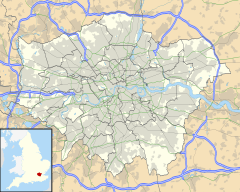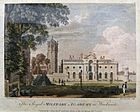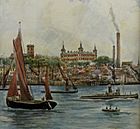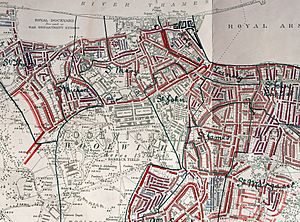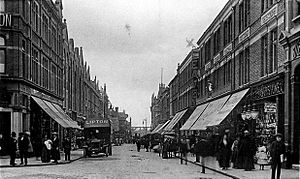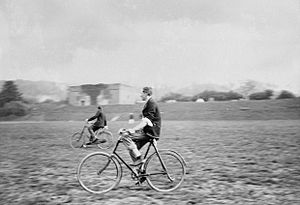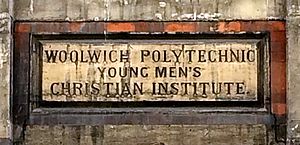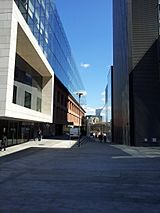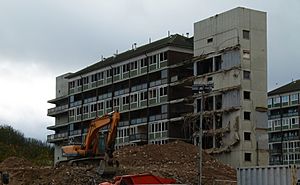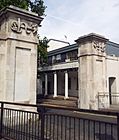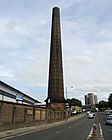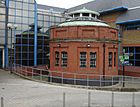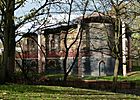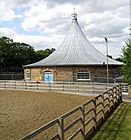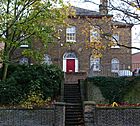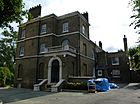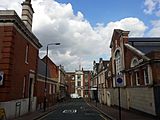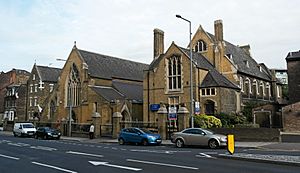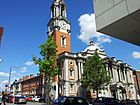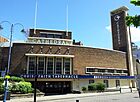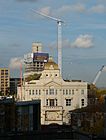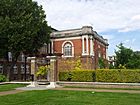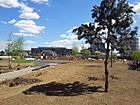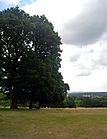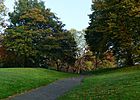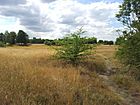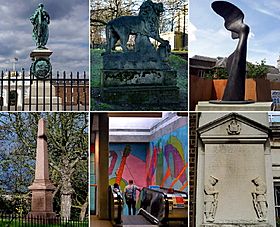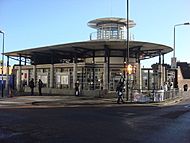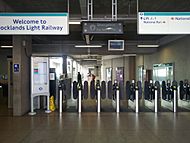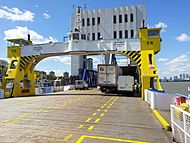Woolwich facts for kids
Quick facts for kids Woolwich |
|
|---|---|
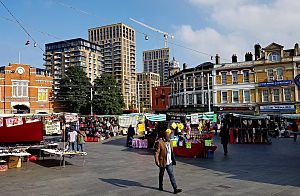 Beresford Square market with Royal Arsenal Gatehouse (left) and Crossrail development in the background |
|
| Population | 84,959 (2011 Census) |
| OS grid reference | TQ435795 |
| • Charing Cross | 8.5 mi (13.7 km) WNW |
| London borough | |
| Ceremonial county | Greater London |
| Region | |
| Country | England |
| Sovereign state | United Kingdom |
| Post town | LONDON |
| Postcode district | SE18 |
| Dialling code | 020 |
| Police | Metropolitan |
| Fire | London |
| Ambulance | London |
| EU Parliament | London |
| UK Parliament |
|
| London Assembly |
|
Woolwich is a town in southeast London, England. It is part of the Royal Borough of Greenwich.
Woolwich is located right on the River Thames. This made it a very important place for the navy, military, and factories for many centuries, from the 1500s to the 1900s. After some tough times, the area is now getting a big makeover with new buildings and projects.
Contents
Exploring Woolwich's Location
Woolwich is about 13.7 kilometers (8.5 miles) from Charing Cross in central London. It has a long riverside area, stretching 2.5 kilometers (1.5 miles) along the south bank of the River Thames. From the river, the land quickly rises up towards Shooter's Hill.
The old area of Woolwich included North Woolwich, which is now part of the London Borough of Newham. Today, Woolwich is mainly made up of the Woolwich Riverside and Woolwich Common areas. In 2011, the population of Woolwich was about 84,959 people.
Woolwich's Interesting History
Early Beginnings
People have lived in Woolwich for a very long time, since at least the Iron Age. Old remains of a fort were found near the river. This fort might have been an important port even before London became famous.
The name Woolwich probably comes from an old Anglo-Saxon word. It means "trading place for wool." In 2015, archaeologists found an old Saxon burial site with 76 skeletons from the 600s or 700s. This shows it was an early Christian settlement. The first church in Woolwich was built around 1100.
For a long time, Woolwich was controlled by monks from Ghent in Belgium. It was a small village that often flooded. The Woolwich Ferry was first mentioned in 1308, but it might be even older.
A Military Powerhouse

Woolwich began to grow a lot in the early 1500s. It became a major center for ships, the military, and factories. In 1512, Woolwich Dockyard was started by Henry VIII to build his famous ship, the Henry Grace à Dieu. Many other great ships were built here, like the Beagle. The dockyard operated for 350 years, closing in 1869.
Next to the dockyard, the Royal Arsenal grew from a storage area into a huge complex of military factories. It played a key role in Britain's military growth. During wartime, thousands of people worked here. The Royal Artillery (1716) and the Royal Military Academy (1741) also started here. They later moved to Woolwich Common. Today, Woolwich still has an army base at the Royal Artillery Barracks.
How Woolwich Grew
People and Jobs
In the 1600s, Woolwich had only a few hundred people. By 1801, it had almost 10,000. During the Napoleonic Wars, the population jumped to 17,000. Woolwich grew quickly with houses for workers near the river and homes for officers higher up the hill. By 1861, there were over 41,000 people living here.
Woolwich had a mix of people, from skilled engineers to factory workers, and many soldiers. Some areas near the river were very crowded.
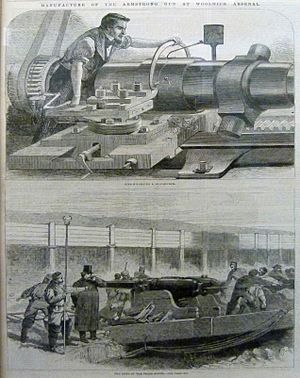
The navy yard was the main employer for a long time. Workers there were paid well because the area was not very healthy. The number of soldiers also grew. During the Napoleonic Wars, the Royal Arsenal employed as many as 5,000 people. After the wars, many lost their jobs, which caused problems.
The dockyard and arsenal also helped other businesses grow, like shops and entertainment. In 1863, the German company Siemens & Halske built a factory in Woolwich to make underwater cables.
Shops and Markets
Woolwich market has been around for a very long time, getting its official charter in 1618. It eventually moved to its current spot at Beresford Square. This market was very busy. Powis Street and Hare Street became the main shopping streets, and some of their old Victorian shop fronts can still be seen today.
In 1868, the Royal Arsenal Co-operative Society started. It grew into one of the biggest co-op businesses in the country. It had large department stores, many shops, factories, and even a building society.
Fun and Games
In the 1700s, Woolwich Cricket Club was well-known. Cricket and other sports were popular among military students and officers. Arsenal F.C. was started in 1886 by workers at the Royal Arsenal. They were first called Dial Square, then Royal Arsenal, and then Woolwich Arsenal. They played in Plumstead before moving to North London in 1913.
Woolwich also had many theaters and cinemas. The Theatre Royal was the oldest, built in the 1830s. Later, the Woolwich Empire, the Century cinema, and the Grand Theatre opened. Some of the big cinemas from the 1930s, like the Granada and the Odeon, are now churches.
Roads and Transport
The River Thames was the main way to travel to London until trains arrived. In 1834, the Woolwich Steam Packet Company improved river travel. In 1889, the Woolwich Free Ferry made it easy to cross the river. The North Kent Line railway opened in 1849, connecting Woolwich to London. Woolwich also had trams from 1881 to 1952.
After World War II, many changes happened. Roads were made wider, and old neighborhoods were replaced with new housing, including tall buildings. An experimental car park called the Auto Stacker was built in 1961 but never worked and was taken down in 1962.
Learning and Schools
Woolwich Polytechnic was founded in 1891. It grew over the years and in 1970 became Thames Polytechnic. In 1992, it became the University of Greenwich. The university moved to Greenwich in 2001, but a small office remains in Woolwich.
Woolwich was also home to the UK's first free kindergarten, which opened in 1900.
Local Government
Woolwich became part of London in the mid-1800s. In 1900, Woolwich, Eltham, and Plumstead joined to form the Metropolitan Borough of Woolwich. The new Woolwich Town Hall opened in 1906. In 1965, Woolwich became part of the Royal Borough of Greenwich. The main offices for the borough are in Woolwich.
Recent History
Changes and Challenges
Woolwich faced tough times in the late 1900s. The Royal Ordnance Factory closed in 1967, and the Siemens factory closed in 1968. Other big companies also left. This led to many people losing their jobs. The town's population also changed, with many new residents from different countries.
In 1974, there was a bombing at the Kings Arms pub, which caused deaths. During the unrest in 2011, some buildings in Woolwich were damaged, including a pub that was set on fire.
The army's 16th Regiment Royal Artillery left Woolwich in 2007. However, the barracks still house the Royal Artillery Band and other army units.
New Beginnings
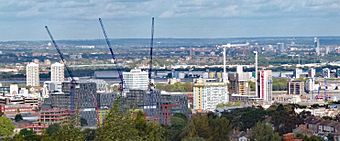
Woolwich is now experiencing a comeback. The old Royal Arsenal site has been redeveloped with apartments, parks, shops, and cafes. Thousands of new homes have been built or are being built, especially tall apartment buildings near the river.
The Woolwich Arsenal DLR station opened in 2009, making it easier to travel to other parts of London. Woolwich was also a venue for shooting events during the 2012 Summer Olympics. The arrival of Crossrail (Elizabeth line) in 2022 is expected to bring even more growth to the area.
A big project started in 2011 to redevelop the area around General Gordon Square. This included building the Woolwich Centre, which has a public library and council offices, and new homes above a Tesco supermarket. Other areas are also being redeveloped with new apartments and shops.
Even old buildings like the RACS department store are being turned into apartments and shops. The former RACS Central Stores building is now a hotel.
Woolwich's Historic Buildings
Woolwich has many historic buildings that show its past as a military and industrial town. The area around the Royal Arsenal is a special conservation area.
Royal Arsenal Buildings
Many old buildings at the Royal Arsenal have been restored. The Royal Brass Foundry (1717) is a very important historic building. Other notable buildings include the Dial Arch (1717–20), the Old Royal Military Academy (1720), and the Grand Store (1806–13). The Royal Arsenal Gatehouse is also a famous landmark.
Dockyard and Riverside
Not much of the original Woolwich Dockyard remains. However, you can still see some 18th-century buildings like the entrance gate, guardhouse, and the Clock House. Two 19th-century docks are also still there. The Dockyard chimney is a well-known landmark.
The entrance to the Woolwich foot tunnel is a round building from 1912. Further west, the Thames Barrier is an amazing example of modern engineering. The Thames Path is a walking trail that connects these sites.
-
Entrance building Woolwich foot tunnel
Other Military Sites
Woolwich has many other important military buildings. The Royal Artillery Barracks has the longest building facade in London. Across the road is Government House (1781). The Garrison Church of St George was bombed in World War II, but its impressive ruins and mosaics can still be seen. John Nash's Rotunda, a round brick building, used to be a museum and is now used for boxing.
The Royal Military Academy at the south end of Woolwich Common also has a very long building in a Mock Tudor style. Other surviving military buildings include Connaught Barracks (1780) and the Royal Herbert Hospital on Shooter's Hill.
-
Ruined Garrison Church (1863)
Woolwich Town Centre
Most of the very old town of Woolwich near the river is gone. In the early 1800s, the town center moved south to where it is now, around Powis Street, Beresford Square, and the Bathway Quarter. Even with changes, there are still interesting buildings here. The Bathway Quarter has the old Public Baths, the Old and New Town Hall, and the former Magistrates Court.
In Powis Street and Hare Street, you can see some old Victorian shop fronts. The western end of Powis Street has two former Royal Arsenal Co-operative Society (RACS) department stores, one Victorian and one in Art Deco style. Near the river are two large cinemas built in 1937, which are now churches. The former Odeon Cinema is a great example of Art Deco style.
Not many of the grand houses that once lined Woolwich Common are left. The Woolwich parish church, St Mary Magdalen, is a simple brick building from the 1730s. Other interesting religious buildings include the Roman Catholic St Peter's Church and two Sikh gurdwaras.
Green Spaces in Woolwich
Parks in central Woolwich are usually small. St Mary's Gardens is a romantic park built on an old churchyard. It has old grave markers and a viewpoint with views of the River Thames. At the Royal Arsenal, new parks and gardens have been created.
Larger green areas like Shrewsbury Park, Plumstead Common, Woolwich Common, and Oxleas Wood are higher up the hill. They are all part of the South East London Green Chain, a network of green spaces.
Sports and Fun in Woolwich
Arsenal F.C. started in Woolwich. Charlton Athletic's stadium, The Valley, is about 2 kilometers (1.2 miles) west of Woolwich. There are also two other local football clubs: Bridon Ropes F.C. and Meridian F.C..
Barrack Field at the Royal Artillery Barracks was once a famous cricket ground. Today, it's used for sports like rugby by the Royal Arsenal Rugby Club.
Greenwich Council plans to build a new leisure center in Woolwich. There is also an indoor climbing wall in the Docklands area.
Education and Arts
The University of Greenwich has its drama department in the historic Bathway Quarter of Woolwich. The Tramshed, an old electricity building, is now a place for music and entertainment. Woolwich does not currently have any movie theaters, but new ones are planned. The town was used as a filming location for the 2006 movie Children of Men.
Woolwich has the Greenwich Heritage Centre museum at the Royal Arsenal. Second Floor Studios in the Woolwich Dockyard area is one of London's largest groups of artists' studios. You can also find many public sculptures in Woolwich, from Roman times to modern art. One entrance to the Woolwich Arsenal DLR station has a large mural made of tiles.
Getting Around Woolwich
Trains
Woolwich Arsenal and Woolwich Dockyard connect the area with train services to central London and other towns like Dartford. You can also catch Thameslink trains to places like Luton and Rainham.
DLR
The Woolwich Arsenal connects Woolwich to the DLR network. This allows you to travel to places like Bank and Stratford International.
Elizabeth Line
The Woolwich railway station for the Elizabeth line opened in May 2022. This new line provides fast services to Abbey Wood, Canary Wharf, central London, Reading, and Heathrow Airport.
Buses
Many London Buses routes serve Woolwich. They connect the town to various places across London and the surrounding areas, including Abbey Wood, Greenwich, Lewisham, and Thamesmead.
Woolwich Ferry
The free Woolwich Ferry crosses the River Thames to North Woolwich. It carries trucks, cars, cyclists, and people during the day. The Woolwich foot tunnel is also available for pedestrians and cyclists at all times.
River Boats
London River Services, run by Thames Clippers, offer daily boat services to central London from Woolwich Arsenal Pier.
Airport Nearby
London City Airport is not far from Woolwich and was built in the 1980s.
Famous People from Woolwich
Many interesting people have connections to Woolwich:
- Victor Brooks (1918–2000), an actor, was born here.
- Garry Bushell (born 1955), a journalist, was born here.
- Tom Cribb, a famous bare-knuckle boxer from the 1800s, lived and died in Woolwich. A road is named after him.
- Stella Duffy, a novelist, was born in Woolwich.
- Bernardine Evaristo, a writer, grew up here.
- Boy George, the lead singer of Culture Club, grew up in Woolwich.
- Charles George Gordon (1833–1885), a famous general, was born here.
- Joseph Grimaldi (1778–1837), a pantomime clown, lived in Woolwich.
- Jeremy Healy, a DJ, was born here.
- Scott Maslen (born 1971), an actor, was born in Woolwich.
- Noizy (born 1986), an Albanian musician, lived in Woolwich.
- Ray Richardson (born 1964), a painter, was born and lives here.
- Sylvia Syms (1934–2023), an actress, was born in Woolwich.
- Glenn Tilbrook (born 1957), a guitarist, was born in Woolwich.
See also
 In Spanish: Woolwich para niños
In Spanish: Woolwich para niños


